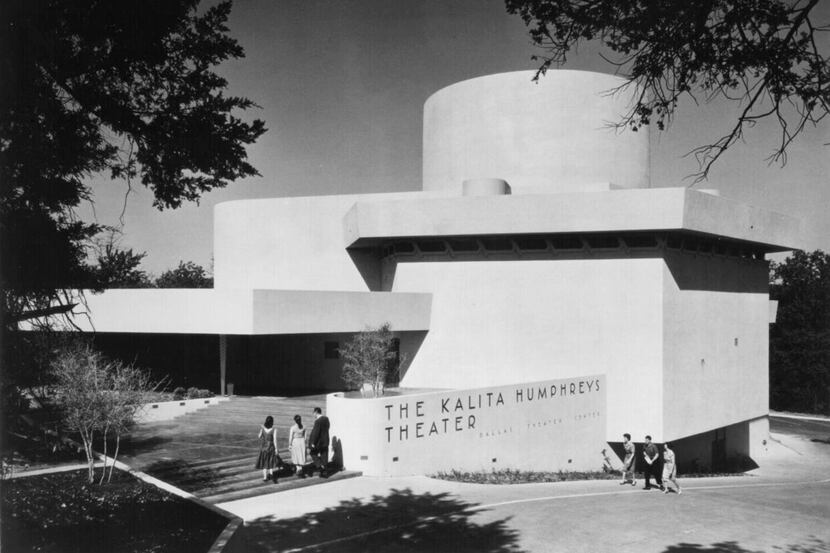This is an update, of sorts, about plans to restore to its glory architect Frank Lloyd Wright's 60-year-old theater nestled in Oak Lawn. Of sorts, because at this moment I can't tell you what those plans are. Or who will oversee their execution. Or pay for them. Or how.
This shouldn't be this hard, a revamp of a decaying Official City Landmark designed by a national treasure. This city has neglected the venue for decades: The structure hasn't had a major capital investment since 1989, which is as unfathomable as it is inexcusable. In a missive sent to the city's cultural arts office, architect William Kelly Oliver, the Wright apprentice who supervised the theater's construction, writes, "I am beginning to wonder if Dallas is aware of the rare thing they have in the Kalita Humphreys Theater."
Everyone wanting to be involved in efforts to make over the Kalita — "a masterpiece of structural daring wedged with care into a verdant landscape" writes my colleague Mark Lamster — agrees it must rescued from its slow decay. All concur the restoration must also take into account the 9.9-acre city park that surrounds it and the Katy Trail that jogs behind it. And, they recognize its rehab should take into account both the entity for which the Kalita was built, the Dallas Theater Center, and other arts groups wishing to use its space.
Yet here we are, almost a decade after completion of a master plan never adopted or executed, and we still see no resolution or restoration. Instead the theater's defenders and the city are mired in disagreements over what the redo should look like, who should oversee it, who will fund it. For years I've heard of progress, of disagreements dashed. Instead, I see only more wrestling and fretting while the Kalita crumbles.
The touring production of this long-running drama came to Dallas City Hall on Monday morning, during a meeting of the City Council's Quality of Life, Arts & Culture Committee.
The briefing room, even with terrible sight lines and muddy sound, was full. The audience divvied into factions — from the theater center and the Arts District and AT&T Performing Arts Center, the city's Arts and Culture Advisory Commission and the historic preservation community. The council took its place at the horseshoe, stars of the show; critics, too, by meeting's end.
Jennifer Scripps, head of the city's Office of Cultural Affairs, came with what she believed to be a viable path forward for the Kalita's restoration.
After several meetings of a task force consisting of five Arts and Culture Advisory commissioners, Scripps said, her office wants to finally and formally renew the Dallas Theater Center's lease at the Kalita to hasten its restoration. Facilities director Nikki Christmas reminded the council that the DTC built the venue for a cost of $1 million in 1959. Fifteen years later the DTC donated the Kalita to the city, and rented it back at the cost of $1 per year.
That lease expired in 2011, two years after the DTC moved into its new home at the Wyly Theatre in the Arts District, and the contract has remained in "holdover" status since then. Yet the DTC continues to use the space — a production of Real Women Have Curves opens at the Kalita this Friday — in conjunction with Uptown Players.
Scripps says the new lease would task the DTC with funding the master plan's update, for which the center would need to raise about $200,000. Kevin Moriarty, the DTC's artistic director, said this week the update is needed because the 2010 plan was completed before the growing DTC realized it would need the Kalita for more than occasional performances. At the time, too, the city promised smaller arts groups space in the then-under-construction City Performance Hall (now called the Moody), which, upon completion, lacked two black-box theaters that had been part of the original design.
Moriarty said the city "didn't have a strong vision" of what the Kalita "needed to be, so all those consultants did their best to create a plan that honored the building's historic legacy."
"But the needs of Dallas have changed," he said, "and I think we can honor these and help strengthen the arts of Dallas for the next 50 years."
Such a long-lasting makeover could ultimately cost upward of $30 million to $40 million. Which, at present, no one has.
The city would also task the DTC with writing an Equitable Access Plan, for the Kalita and other buildings on the grounds, so that smaller arts groups could use the space. That's a central tenet of City Hall's new Cultural Arts Plan. But DTC leadership says it can't take on those tasks without a long-term lease at the Kalita, which the city admits it has neglected at every turn.
"What is required of us in the proposal is tremendous amount of work and at tremendous cost," DTC's managing director Jeff Woodward said this week. "We can't take on those two studies if we don't have at least an assurance we can guide the process."
But returning control of planning for the theater to the DTC is also the last thing thing preservationists and the recently formed Kalita Humphreys Theater at Turtle Creek Conservancy want. Preservationists also blame the DTC for letting the theater rot during its original decades-long tenancy.
The conservancy, backed by board members of the Frank Lloyd Wright Building Conservancy and other national architects, wants to stick with the 2010 master plan, which would return the theater's interior and exterior to Wright's 1959 specs. The conservancy also wants to reshape the campus around it, which would likely include new buildings and a link between the Katy Trail and William B. Dean Park along Turtle Creek.

Ann Abernathy, the preservation architect who worked on the 2010 plan and continues to champion it, told the council Monday that the Dallas Theater Center "should not be privately funding and in charge of a plan for an entire nine-acre park they have no jurisdiction over."
Abernathy and other other preservationists want the city to fund the plan overhaul. They want, too, for the conservancy to have a strong hand in guiding the process so it can render the entire site a tourist destination — a World Heritage Site, even, said Landmark Commission chair Katherine Seale, who has been consulting with the conservancy.
"What the conservancy is saying is, when you have this incredible asset sitting in such a dilapidated state, why wouldn't the city take a grander approach?" she told me this week. "There's so much potential. A lot of people not only in Dallas but around the country see this as an incredible asset, a civic asset to share. Everybody would like a seat at the table."
Scripps came to council Monday hoping to get the lease extension approved before June's end. But some council members want her to put the master plan update out for bids. Which means further delays, though everyone agrees saving the Kalita isn't just a civic necessity, but a moral responsibility.
"We don't have to solve this in the next month," Moriarty said. "But we don't have another decade to do nothing."
And I don't think anyone disagrees with that.

